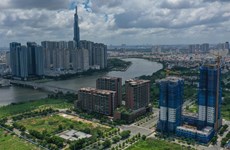Tra Vinh to grow high-value crops on low-yield rice fields
The Mekong Delta province of Tra Vinh plans to switch to high-value crops on more low-yield rice fields and use advanced farming techniques to improve farmers’ incomes in the next five years.
 A gac (Momordica cochinchinensis) farming model adopted by the Viet Thanh Agriculture Cooperative in Tra Vinh province’s Cau Ke district offers high incomes (Source: VNA)
A gac (Momordica cochinchinensis) farming model adopted by the Viet Thanh Agriculture Cooperative in Tra Vinh province’s Cau Ke district offers high incomes (Source: VNA)Tra Vinh (VNS/VNA) - The Mekong Delta province of Tra Vinh plans to switch to high-value crops on more low-yield rice fields and use advanced farming techniques to improve farmers’ incomes in the next five years.
Of 8,108ha on its radar, the Department of Agriculture and Rural Development said 4,258ha would see a complete switch to short-term crops, 2,487ha would be used for perennial trees and the remaining 1,363ha would have rice and aquatic species.
Pham Minh Truyen, director of the department, said to ensure an efficient switch the department in cooperation with localities would step up advocacy for the programme and related incentives.
It encourages farmers to join cooperative groups and cooperatives to improve their efficiency and link up with companies to secure outlets, he said.
The province would focus on research and creating new varieties of crops with high yields and quality that can adapt to climate change and are resistant to diseases, he said.
It would implement the preferential policies of both central and local governments related to switching from rice to other crops and investment in agriculture, he said.
Since 2015 more than 18,300ha have been converted, he said.
Other crops offer 1.3-7.6 times the income rice does, according to the department.
Farmers in the province now earn an average of 130 million VND (5,600 USD) per hectare per year, 6.3 million VND higher than in 2015 while aquaculture yields 360 million VND (15,600 USD), an increase of 110 million VND.
The province has also encouraged farmers with a total of 9,000ha growing a mix of various other crops to switch to high-value fruits, coconut, vegetables, and timber.
On such lands, farmers should identify which of their crops is suitable for growing, especially drought-resistant, and stick to those, the department said.
Most of these lands are in Cau Ngang, Tra Cu, Duyen Hai, and Chau Thanh districts, have sandy soil, are one to four metres above sea level, and grow various kinds of plants including bamboo and timber, it said.
Truyen said most of these lands yield low incomes, and so their owners are encouraged to switch to mango, longan, milk apple, jackfruit, peanut, water melon, vegetables, and other crops.
To encourage the switch, the province provides subsidies to farmers, cooperatives, cooperative groups, and companies for buying seeds, fertilisers, and pesticides.
They receive 6-12 million VND (260-520 USD) per hectare in the first year and 3-5 million VND (130-216 USD) in the second for up to 50ha of lands.
Authorities have taken measures to popularise advanced techniques to improve the yield and quality of agricultural products and thus farmers’ incomes.
The province’s Farmers Association has helped nearly 4,000 farmers adopt advanced techniques in recent years.
They include using hydroponics, net houses and poly greenhouse farming, cultivating crops to Vietnamese and global good agricultural practices (VietGAP and GlobalGAP) standards and breeding aquatic species using intensive farming and super-intensive farming methods.
A model of growing honeydew melon in poly greenhouses in Chau Thanh district, for instance, brings farmers an income of 1.2-1.8 billion VND (51,860-77,800 USD) per hectare per year.
Nguyen Tuong Linh, deputy head of the Chau Thanh Bureau of Agriculture and Rural Development, said the model, with drip irrigation, helps save water, prevent pests, and reduce the use of pesticides.
“It is a sustainable agricultural production model and suitable for use amid climate change.”
The province has nearly 17,000ha of lands using advanced farming techniques, or 4.5 percent of its total farmlands, according to the department.
It has created brand names for 26 agricultural products and developed agricultural cooperatives and value chains to improve farmers’ incomes.
The province’s rural per capita income area has risen 1.2 times since 2015 to 32 million VND (1,380 USD)./.












